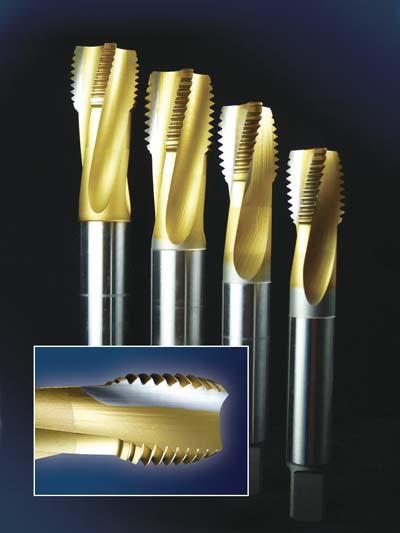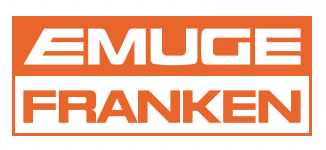
Emuge Corp. introduced a tap with superb chip-breaking capabilities that is ideally designed for machining applications in the energy and related industries. The new Rekord DZ Series Taps feature technology developed by Emuge that eliminates the formation of long continuous chips that commonly occur when tapping carbon steels, alloy steels, and austenitic stainless steels.
The taps are designed with a newly developed cutting face geometry and spiral flute form, which combine to affect chip flow, chip curl and chip length. This innovative Emuge chip-breaking technology produces short, broken, controllable chip formations that eliminate flute clogging and potential failure of the machine tap due to chipped cutting teeth or breakage. This technology contributes to higher reliability of the threading process, eliminates machine down time required to clean chips, improves tool life, produces a better surface finish and also increases operator safety.
"Our new chip-breaking capability is a testament to Emuge's unwavering commitment to developing the latest cutting tool technology," said Mr. Mark Hatch, Product Director of Taps and Threads Mills at Emuge Corp. "The new chip-breaking design we've developed is going to drastically improve tapping in difficult applications such as in the oil field, petrochemical and power generation industries."
Made of premium cobalt high speed steel and ground with eccentrically relieved threads which feature full pitch diameter relief, the Rekord DZ Series reportedly provide greater tool life and machining efficiency than conventional taps. The tap is surface treated with TIN to reduce friction between the tap and work piece, which results in improved thread finishes and increased tool life in carbon and alloy steels, cast and forged steels, tool and die steels and 300 stainless steel up to 35 HRC.
The new Rekord DZ Series Taps are ground with an increased pitch diameter, designated 2BX, which optimizes the gage tolerance for a 2B class-of-fit, in order to add an additional wear allowance for improved tool life. The taps are also made with Emuge's trademark long shanks, DIN length for extra reach, improved chip evacuation, cooling and lubrication.
Emuge has also designed the new taps to be used in both horizontal and vertical machining applications, which saves tooling changeover time and eliminates the need to stock two lines of taps in the tool crib. Also, a modified bottom chamfer is ideally suited for blind holes. The new Emuge Rekord DZ Series is offered in inch sizes ranging from ½" to 2".
Contact Details
Related Glossary Terms
- alloy steels
alloy steels
Steel containing specified quantities of alloying elements (other than carbon and the commonly accepted amounts of manganese, sulfur and phosphorus) added to cause changes in the metal’s mechanical and/or physical properties. Principal alloying elements are nickel, chromium, molybdenum and silicon. Some grades of alloy steels contain one or more of these elements: vanadium, boron, lead and copper.
- carbon steels
carbon steels
Known as unalloyed steels and plain carbon steels. Contains, in addition to iron and carbon, manganese, phosphorus and sulfur. Characterized as low carbon, medium carbon, high carbon and free machining.
- pitch
pitch
1. On a saw blade, the number of teeth per inch. 2. In threading, the number of threads per inch.
- relief
relief
Space provided behind the cutting edges to prevent rubbing. Sometimes called primary relief. Secondary relief provides additional space behind primary relief. Relief on end teeth is axial relief; relief on side teeth is peripheral relief.
- stainless steels
stainless steels
Stainless steels possess high strength, heat resistance, excellent workability and erosion resistance. Four general classes have been developed to cover a range of mechanical and physical properties for particular applications. The four classes are: the austenitic types of the chromium-nickel-manganese 200 series and the chromium-nickel 300 series; the martensitic types of the chromium, hardenable 400 series; the chromium, nonhardenable 400-series ferritic types; and the precipitation-hardening type of chromium-nickel alloys with additional elements that are hardenable by solution treating and aging.
- tap
tap
Cylindrical tool that cuts internal threads and has flutes to remove chips and carry tapping fluid to the point of cut. Normally used on a drill press or tapping machine but also may be operated manually. See tapping.
- tapping
tapping
Machining operation in which a tap, with teeth on its periphery, cuts internal threads in a predrilled hole having a smaller diameter than the tap diameter. Threads are formed by a combined rotary and axial-relative motion between tap and workpiece. See tap.
- threading
threading
Process of both external (e.g., thread milling) and internal (e.g., tapping, thread milling) cutting, turning and rolling of threads into particular material. Standardized specifications are available to determine the desired results of the threading process. Numerous thread-series designations are written for specific applications. Threading often is performed on a lathe. Specifications such as thread height are critical in determining the strength of the threads. The material used is taken into consideration in determining the expected results of any particular application for that threaded piece. In external threading, a calculated depth is required as well as a particular angle to the cut. To perform internal threading, the exact diameter to bore the hole is critical before threading. The threads are distinguished from one another by the amount of tolerance and/or allowance that is specified. See turning.
- titanium nitride ( TiN)
titanium nitride ( TiN)
Added to titanium-carbide tooling to permit machining of hard metals at high speeds. Also used as a tool coating. See coated tools.
- tolerance
tolerance
Minimum and maximum amount a workpiece dimension is allowed to vary from a set standard and still be acceptable.

